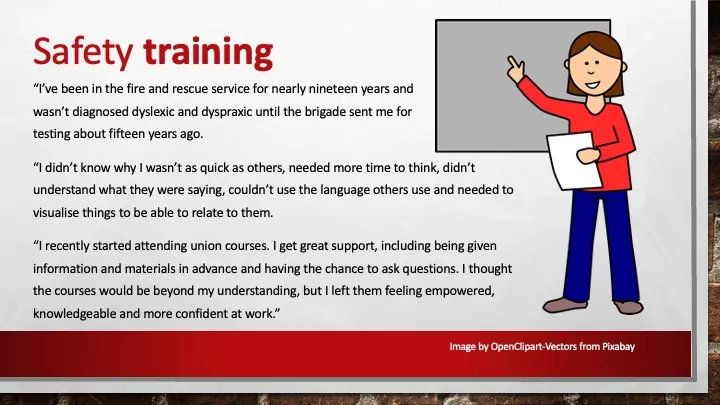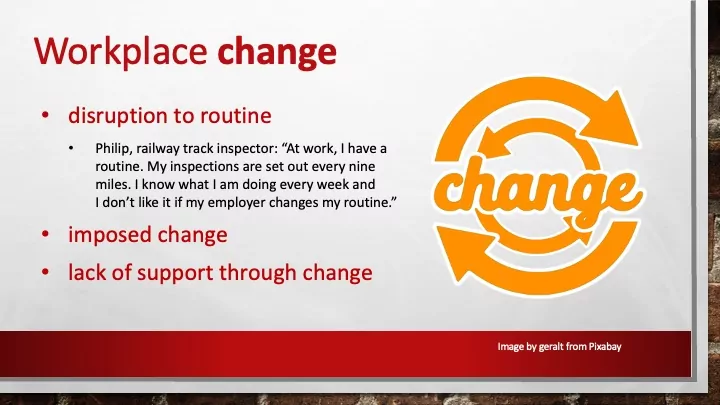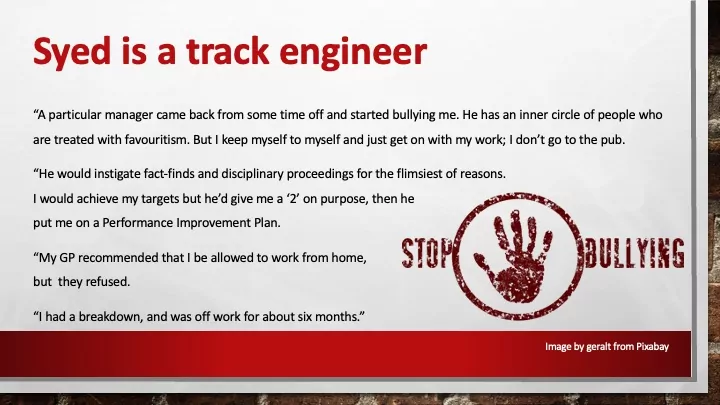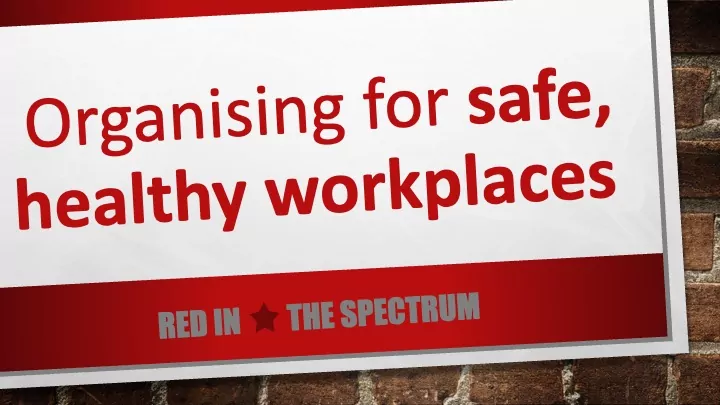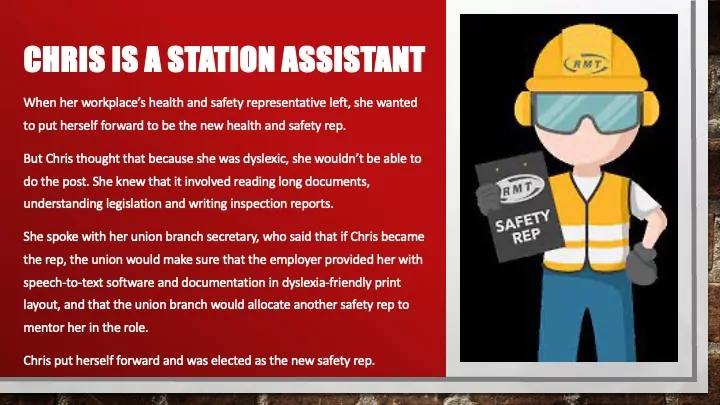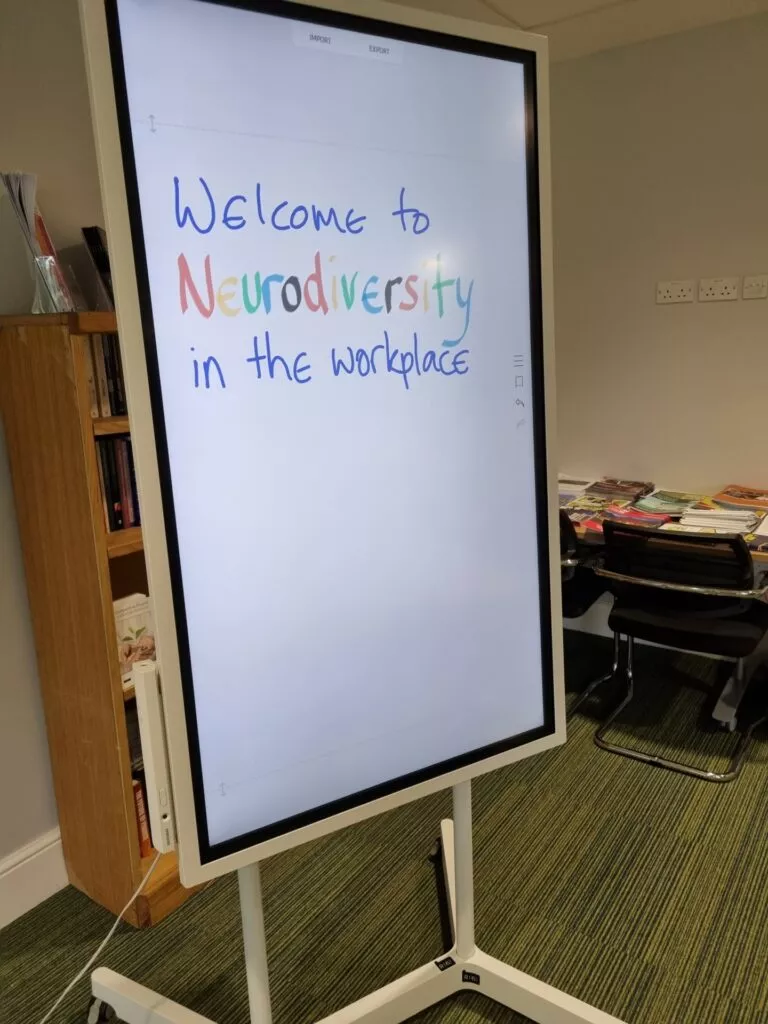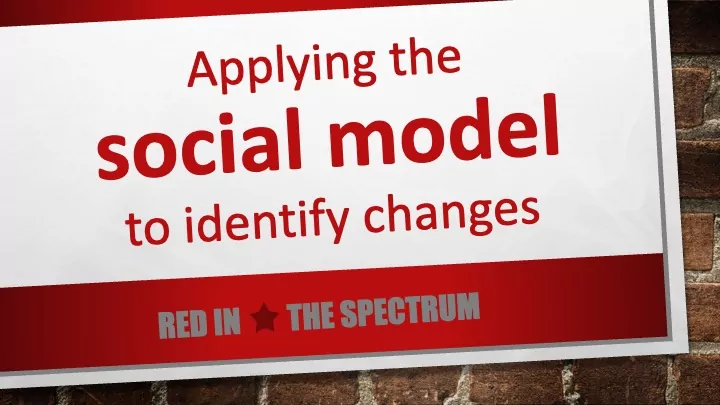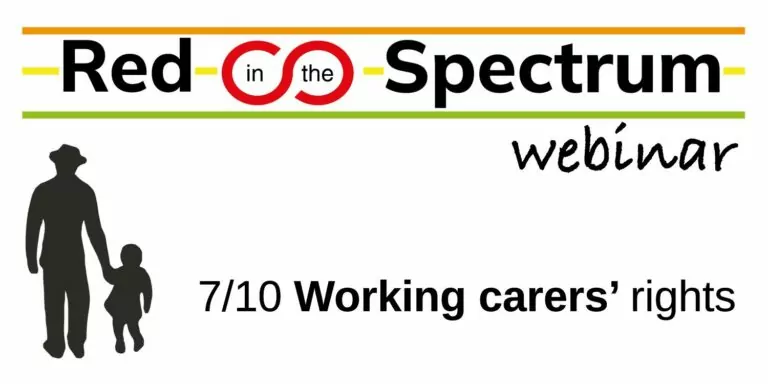Neurodiversity and Workplace Safety: Webinar 9
Neurodiversity and workplace safety
The ninth of Red in the Spectrum’s series of webinars on Neurodiversity at Work was about neurodiversity and workplace safety. It took place on Sunday 10 March 2024.
The webinar began by asserting two principles of workplace safety:
- A neuro-inclusive workplace is a safer workplace.
- A neurodiverse workforce can be a safer workforce if barriers and discrimination are removed.
How neurodiversity can make workplaces safer
Neurodivergent workers can enhance workplace safety, as they may:
- remember and follow workplace safety rules
- have enhanced attention to detail
- notice hazards
- come up with creative ways of solving workplace safety problems
- engage effectively with neurodivergent clients
Laura is a health and safety professional.
“As a generalisation, autistic people are incredibly good at detail. We’re often logical thinkers, precise and we can concentrate for long periods of time. … If you give me 300 pages and ask me to find the errors or specific details, I’ll happily do it. I’m thorough and diligent. I also tend to remember technical information, which means I’m well suited to compliance checking and application,” Laura says.
There are definitely traits of autism that fit very nicely into a health and safety role.
Source: Thinking Differently, IOSH magazine, October 2022
How discrimination and barriers compromise workplace safety
Workplace safety training
“I’ve been in the fire and rescue service for nearly nineteen years and wasn’t diagnosed dyslexic and dyspraxic until the brigade sent me for testing about fifteen years ago.
“I didn’t know why I wasn’t as quick as others, needed more time to think, didn’t understand what they were saying, couldn’t use the language others use and needed to visualise things to be able to relate to them.
“I recently started attending union courses. I get great support, including being given information and materials in advance and having the chance to ask questions. I thought the courses would be beyond my understanding, but I left them feeling empowered, knowledgeable and more confident at work.”
Workplace safety: communication
- following instructions
- Mattaf: “I am not unwilling to listen to instructions – my short-term memory is rubbish, so I will listen to instructions, and immediately forget them.”
- Simon received an instruction from service control to take his train out of service at the station he was approaching. This instruction could have been given earlier but was not. Simon passed a signal at danger, and his manager blamed Simon’s autism rather than the instruction being given so late.
- signage
- unclear
- too much of it!
- announcements
- hard to hear
- noise distress
- reports and documentation
Workplace safety: physical environment
- trip hazards
- overcrowding
- distraction
Contribution from participant:
“Human Resources have had my Reasonable Adjustment request for eight weeks with no response. It includes my two-year-long request for there to be at least a discussion about how the built environment has a negative impact on me.”
Workplace safety: sensory environment
- sensory distress
- sensory overload
- distraction
Contribution from participant:
“I’ve just launched an anonymous form for staff asking about experiences of neurodivergent staff in terms of the campus not being a neuro-inclusive space. This is in conjunction with my colleague in the students’ union launching a campaign for students. Reasonable adjustments have been ignored for years. Staff using earphones and sunglasses for sensory reasons have been told they are antisocial but there are no neuro-safe spaces. My partner cannot believe I have not been got rid of already.”
Workplace safety: change
- disruption to routine
- Philip, railway track inspector: “At work, I have a routine. My inspections are set out every nine miles. I know what I am doing every week and I don’t like it if my employer changes my routine.”
- imposed change
- lack of support through change
Workplace safety: emergencies
“I think that my neurodivergence helps me stay calm and matter-of-fact during workplace emergencies.
“We can be good at dealing with sudden crises if we know that they might happen at any time.
“But for some people, the sudden change will be difficult, and the noise from alarms or the panic of people around them can cause anxiety or even shutdown.”
Contributions from participants:
“Work have been great about Fire Alarms and keep checking that I’m fine after one (I am). Sadly, they are less interested in doing anything about the lighting which has an enormous impact on my wellbeing.”
“I haven’t had to do a lockdown drill yet, where you get to lock yourself in the room with bad lighting only now there’s an alarm going too. This appears to be OK ‘coz the drills happen on a day of the week that I don’t work. Am hoping the real thing will be timed to only occur when I am not at work …”
“Changing the button I need to press to work the photocopier – problem. Walking into the office to discover I need to resuscitate someone, no worries.”
“A friend of mine is being asked to become a fire warden when she previously had as a reasonable adjustment that she could just run outside if the fire alarm went off because she panics and can’t handle the sensory issues. They know she’s autistic but are now saying it is no longer a “reasonable” adjustment because of staffing reductions. How can it be safe to have her in charge when she’ll just melt down anyway? Any arguments I can pass on for her to use, please?” [Answer: Involve the union rep and/or health and safety rep and raise these issues directly with management. A reasonable adjustment does not suddenly become unreasonable because the employer has made cuts!]
Workplace safety: mental health
Syed is a track engineer.
“A particular manager came back from some time off and started bullying me. He has an inner circle of people who are treated with favouritism. But I keep myself to myself and just get on with my work; I don’t go to the pub.
“He would instigate fact-finds and disciplinary proceedings for the flimsiest of reasons.
I would achieve my targets but he’d give me a ‘2’ on purpose, then he put me on a Performance Improvement Plan.“My GP recommended that I be allowed to work from home, but they refused.
“I had a breakdown, and was off work for about six months.”
Contribution from participant:
“Mental health has been a huge issue for me. My boss ticks ALL the points of a toxic manager. She wouldn’t let me work from home (WFH) to focus on my reasonable adjustments request, as it’s not ‘work related’ and other people aren’t allowed to WFH. Then I saw on our work board that someone was WFH that week.”
“I feel that my employer is trying to get rid of me by saying that my mental health has caused me to be off sick for eight months when it was their behaviour that caused the sickness.”
Organising for safe, healthy workplaces
Your rights to workplace safety
You have the right to:
- have any risks to your health and safety properly controlled
- be provided with personal protective and workplace safety equipment free
- stop work and leave your work area if you have reasonable concerns about your workplace safety
- raise health and safety concerns with your employer
- not be disciplined if you contact the Health and Safety Executive or your local authority about workplace safety, if your employer won’t listen to your concerns
- rest breaks during the working day
- be consulted about health and safety via your health and safety representative.
Could you be a health and safety rep?
Health and safety representatives are elected by workers, and have a crucial role in enhancing workplace safety and ensure that workplaces have the highest possible health and safety standards. Information on what this involves is available here.
Chris is a station assistant.
When her workplace’s health and safety representative left, she wanted to put herself forward to be the new health and safety rep.
But Chris thought that because she was dyslexic, she wouldn’t be able to do the post. She knew that it involved reading long documents, understanding legislation and writing inspection reports.
She spoke with her union branch secretary, who said that if Chris became the rep, the union would make sure that the employer provided her with speech-to-text software and documentation in dyslexia-friendly print layout, and that the union branch would allocate another safety rep to mentor her in the role.
Chris put herself forward and was elected as the new safety rep.
Karl is a firefighter.
Karl believes that his autism has helped him. He can hyperfocus on tasks and scan-read and remember large amounts of text very quickly. He achieved academically and in promotion processes scored highly.
His role in the union has flourished because of his hyperfocus. His need for order allows him to prepare case work. He scrutinises and recites large documents. His ability to pre-plan also helps.
Karl has studied for diplomas in employment law, health and safety and equalities.
James is a railway signaller.
“When I realised I was neurodivergent, it felt surreal: how could I, having spent nearly two decades in safety-critical jobs, chairing committees and running events, have ‘something wrong with me’?
“Then it dawned on me: it’s not ‘something wrong’, it’s simply that my brain is wired differently, and in some cases this is a distinct advantage. In the health and safety projects I’ve run, the ‘thinking outside the box’ that comes with my neurodivergence has been a big part of the success.
“Despite my initial concerns – would I be taken off safety-critical duties? – I’ve received nothing but support. I’m a health and safety representative, and I’m now a member of the union’s disabled members’ committee.”
Workplace safety: Guest speaker – Mark Stokes
Mark is a train guard.
“I can remember being told I was stupid but knowing I was not. I found out that I was dyslexic in my last year at school.
“Fourteen years ago, I found my dream job. It was hell at first with learning the rules, routes and rolling stock, but the structure of the railway suits me.
“I became an RMT health and safety representative. I flung myself headfirst into it, attending many courses.
“My passion has given me a reputation of being rather dogmatic, to the point where I will not give up until I have found an answer.”
Mark spoke about being diagnosed as dyslexic at the age of fourteen, and more recently as combined ADHD/autistic.
He gave several examples of how making a fuss about a safety issue at work had won improvements in workplace safety.
He gave participants information about laws about workplace safety, including the 1974 Health and Safety at Work Act and various regulations.
Mark stressed the importance of the ‘Brown Book’ in upholding workplace safety, as it contains lots of information about safety committees and safety reps.
He commented: “I work my train the same way every day, and I love it when something goes wrong! I’m at I best when there’s a problem.”
Questions from participants and answers from Mark:
Q: Were you ever seen as a troublemaker, by making people follow the laws?
A: Definitely. But you have to make trouble to improve workplace safety, so I don’t mind.
Q: I raised a workplace safety concern to the board in writing (that they should have already known) due to lone workers in an office open to the public, when I left my last job. My manager retaliated by trying to say I stole stuff that I had previously handed in before I left the workplace.
A: That’s appalling. That is causing you a detriment because you raised a workplace safety concern, which is unlawful.
Q: Can you force them to put in better Covid mitigation strategies?
A: Raise it with the employer and ask your health and safety rep to take it up. Even though the worst of the pandemic is over, Covid is still an issue and still a workplace safety concern.
Q: So far, all I have out of my union is a very basic letter template.
A: Ask the union rep to do more. There is a lot that they can do to pressure the employer to protect your workplace safety.

